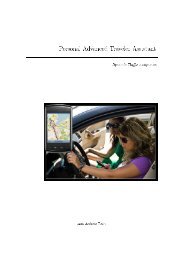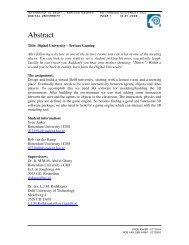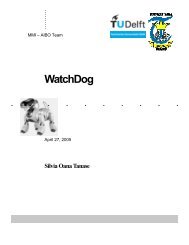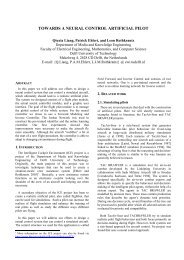Recognition of facial expressions - Knowledge Based Systems ...
Recognition of facial expressions - Knowledge Based Systems ...
Recognition of facial expressions - Knowledge Based Systems ...
Create successful ePaper yourself
Turn your PDF publications into a flip-book with our unique Google optimized e-Paper software.
<strong>facial</strong> feature and store the information regarding<br />
the variability <strong>of</strong> the data.<br />
2. Related work<br />
The typical problems <strong>of</strong> expression recognition<br />
have been tackled many times through distinct<br />
methods in the past. In [12] the authors proposed<br />
a combination <strong>of</strong> a Bayesian probabilistic model<br />
and Gabor filter. [3] introduced a Tree-<br />
Augmented-Naive Bayes (TAN) classifier for<br />
learning the feature dependencies. A common<br />
approach was based on neural networks. [7] used<br />
a neural network approach for developing an<br />
online Facial Expression Dictionary as a first<br />
step in the creation <strong>of</strong> an online Nonverbal<br />
Dictionary. [2] used a subset <strong>of</strong> Gabor filters<br />
selected with Adaboost and trained the Support<br />
Vector Machines on the outputs.<br />
3. Eye tracking<br />
The architecture <strong>of</strong> the <strong>facial</strong> expression<br />
recognition system integrates two major<br />
components. In the case <strong>of</strong> the analysis applied<br />
on video streams, a first module is set to<br />
determine the position <strong>of</strong> the person eyes. Given<br />
the position <strong>of</strong> the eyes, the next step is to<br />
recover the position <strong>of</strong> the other visual features<br />
as the presence <strong>of</strong> some wrinkles, furrows and<br />
the position <strong>of</strong> the mouth and eyebrows. The<br />
information related to the position <strong>of</strong> the eyes is<br />
used to constrain the mathematical model for the<br />
point detection. The second module receives the<br />
coordinates <strong>of</strong> the visual features and uses them<br />
to apply recognition <strong>of</strong> <strong>facial</strong> <strong>expressions</strong><br />
according to the given emotional classes. The<br />
detection <strong>of</strong> the eyes in the image sequence is<br />
accomplished by using a tracking mechanism<br />
based on Kalman filter [1]. The eye-tracking<br />
module includes some routines for detecting the<br />
position <strong>of</strong> the edge between the pupil and the<br />
iris. The process is based on the characteristic <strong>of</strong><br />
the dark-bright pupil effect in infrared condition<br />
(see Figure 1).<br />
However, the eye position locator may not<br />
perform well in some contexts as poor<br />
illuminated scene or the rotation <strong>of</strong> the head. The<br />
same might happen when the person wears<br />
glasses or has the eyes closed. The<br />
inconvenience is managed by computing the<br />
most probable eye position with Kalman filter.<br />
The estimation for the current frame takes into<br />
account the information related to the motion <strong>of</strong><br />
the eyes in the previous frames. The Kalman<br />
filter relies on the decomposition <strong>of</strong> the pursuit<br />
eye motion into a deterministic component and a<br />
random component. The random component<br />
models the estimation error in the time sequence<br />
and further corrects the position <strong>of</strong> the eye.<br />
It has a random amplitude, occurrence and<br />
duration. The deterministic component concerns<br />
the motion parameters related to the position,<br />
velocity and acceleration <strong>of</strong> the eyes in the<br />
sequence. The acceleration <strong>of</strong> the motion is<br />
modeled as a Gauss-Markov process. The<br />
autocorrelation function is as presented in<br />
formula (1):<br />
R(t )<br />
σ<br />
2 -b |t|<br />
= e (1)<br />
The equations <strong>of</strong> the eye movement are defined<br />
according to the formula (2). In the model we<br />
use, the state vector contains an additional state<br />
variable according to the Gauss-Markov process.<br />
u(t) is a unity Gaussian white noise.<br />
z<br />
x&<br />
x&<br />
x&<br />
1<br />
2<br />
3<br />
=<br />
0<br />
0<br />
0<br />
1<br />
0<br />
0<br />
0<br />
1<br />
− β<br />
2<br />
= [ 2σ<br />
β 0 0]<br />
x<br />
x<br />
x<br />
x<br />
x<br />
x<br />
1<br />
2<br />
3<br />
1<br />
2<br />
3<br />
+<br />
0<br />
0 u(<br />
t)<br />
1<br />
(2)<br />
The discrete form <strong>of</strong> the model for tracking the<br />
eyes in the sequence is given in formula (3).<br />
φ = e ∆<br />
f t<br />
, w are the process Gaussian white<br />
noise and n is the measurement Gaussian white<br />
noise.<br />
Figure 1. The dark-bright pupil effect in infrared<br />
x<br />
z<br />
k<br />
k<br />
= φ + w<br />
k<br />
= H<br />
k<br />
⋅ x<br />
k<br />
k<br />
+ v<br />
k<br />
(3)<br />
127
















